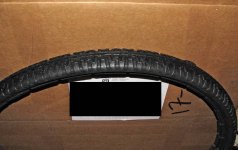Reid Welch
1 MW
Collected by google search.
Looking for all aspects, not just sellers' claims
----
____________________________
____________________________
http://www.flatfreeusa.com/eng/product/categories.php?cat_id=7


___________________________
Now looking for reviews:
http://www.snappingturtle.net/gigantichound/archives/004933.html
screenshot is not active-go to the original page instead for hyperlinks

____"Mr. Bike" sez:

__________
"Slows you down somewhat"
Reid asks: why is that? Why don't the sellers say that?
Building in lossy drag is not as much an issue for some of us.
See Sheldon Brown's article again: 'OK for smooth surfaces,
heavy, slow'. And he has points.
Where are all of the other airless tire makers?
Why don't the mainstream makers offer airless tires

Looking for all aspects, not just sellers' claims
----
http://www.bikemania.biz/Complete_Nu_Teck_Airless_Tire_Installation_Tool_p/nu_installtool.htm
ALL Nu-Teck products ordered after December 18th, will be shipped on January 9th.
ONLY SOLD WHEN A NU-TECK TIRE IS PURCHASED AT THE SAME TIME Installation of a Nu-Tech tire requires the use of a Nu-Tech installation tool! How To Use Install Tool REMOVE THE RIM RUBBER STRIP BEFORE INSTALLING THE TIRES Place the tire on the rim and secure with toe strap or tie cord. Make sure the tire is seated into the rim. Now work the tire into the rim approximately half way around the rim and secure with additional strap or cord. Fit the remainder of the tire onto the rim by gently stretching the tire, using the tire tool. The tire will stretch. Take small (1 to 2 inch) sections and work around the rim, fitting the tire into the rim groove. As the final section is fitted, the tire will snap into place. With your hands, work the tire all around to ensure it is seated uniformly. the tire is made to fit snugly and is smaller than the rim. Use gentle persuasion during the installation.
Before you place an order for these tires, please measure your rims by following the instructions found below to determine if this tire is the appropriate fit for your rims.
Also, installation of a Nu-Tech tire requires the use of a Nu-Tech installation tool!
Imagine a bicycle tire impervious to rusty nails, broken glass, sharp rocks and thorns.
Dream on you say!!
Nu-Teck has introduced a full line of flat-proof, leak-proof and maintenance free tires.
No way, you say?
Here’s how:
Each tire is made of hundreds of thousands of microscopic air cells trapped in a matrix of incredibly tough polyurethane. The result is a tire that is amazingly light-weight, incredibly durable and easier to roll than ordinary rubber tires. Lose the pump, patch kit and problems associated with rusty nails, broken glass and thorns!
Micro-Cellular Polyurethane tires are designed to be the most technically advanced tires ever developed, utilizing, perhaps, the most versatile, state-of-the-art formulations. The revolutionary process used is quite unique developing, perhaps the finest, unsurpassed qualities inherent to the actual tires.
SIZE: 26 X 2.0
WEIGHT: 980 grams
Equivilent PSI: 45-55
Bead Width: 24-25 mm
Bead Depth: 8-9 mm
Installation of a Nu-Tech tire requires the use of a Nu-Tech installation tool!
The following elaborates on some of the unique qualities of MICRO-CELLULAR TIRES:
* Uniform, efficient, free of imperfections generally found in the common rubber tire.
* Manufactured from synthetic materials in combination and area not susceptible to breakdown from climatic conditions, chemical hazards, weather, etc.
* Typically lighter than the conventional rubber tires and tube.
* Extremely strong, durable and wear-resistant exceeding the wear co-efficient of rubber tires by up to 200%-300%.
* Provide a feel of soft air-cushioned ride yet they are airless, flat proof, leak proof and virtually maintenance free.
* Absolutely non-marking.
* Full molded, self skinned and mount on most standard rims with inexpensive mounting tools.
* Will not roll off even under the most rigorous riding conditions.
* Competitively priced with regular rubber tires and thorn-proof tubes.
A tire that’s guaranteed to never go flat!!
FEATURES:
Weight - equal to or less than pneumatic tire and tube.
High resistance to wear and tear. Laboratory tests have shown expected life span two to four times longer than a rubber tire.
A wide range of airless tire ‘pressures’ can be made available to provide the riding quality and firmness normally associated with rubber pneumatic tires.
Variable airless tire pressures can be simulated from 30 psi to 175 psi.
Guaranteed never to go flat!!
Maintenance free - no need for inner tubes, air pumps and puncture (repair) kits.
All airless tires are made in a fully molded snap-on style to fit a wide range of rims.
Airless tires install easily in seconds with our tool and don’t roll off - even under the most rigorous conditions.
Airless tires performed as well or better than pneumatic tires in tests performed by an independent testing laboratory.
Accessories for this product...
Complete Nu-Teck Airless Tire Installation Tool
Our Price: $25.99
Add
Related Products...
Nu-Teck 24 X 1.75 All Purpose Airless Tire
Our Price: $25.25
Add
Flat-proof, leak-proof and maintenance free
Nu-Teck 26 x 2.0 HP Mountain Bike Airless Tire
Our Price: $31.31
Add
Imagine a bicycle tire impervious to rusty nails, broken glass sharp rocks, thorns!
Nu-Teck 12" SCOOTER, JOGGER, STROLLER Tire
Our Price: $21.95
Add
Flat-proof, leak-proof and maintenance free
Nu-Teck 16 X 1-3/8-1.75 Street Tire
Our Price: $27.75
Add
Flat-proof, leak-proof and maintenance free
Nu-Teck 700 X 20TT Speed Airless Tire
Our Price: $40.95
Add
Imagine a bicycle tire impervious to rusty nails, broken glass sharp rocks, thorns!
Share your knowledge of this product with other customers... Be the first to write a review.
____________________________
____________________________
http://www.flatfreeusa.com/eng/product/categories.php?cat_id=7


___________________________
Now looking for reviews:
http://www.snappingturtle.net/gigantichound/archives/004933.html
screenshot is not active-go to the original page instead for hyperlinks

____"Mr. Bike" sez:

__________
"Slows you down somewhat"
Reid asks: why is that? Why don't the sellers say that?
Building in lossy drag is not as much an issue for some of us.
See Sheldon Brown's article again: 'OK for smooth surfaces,
heavy, slow'. And he has points.
Where are all of the other airless tire makers?
Why don't the mainstream makers offer airless tires






